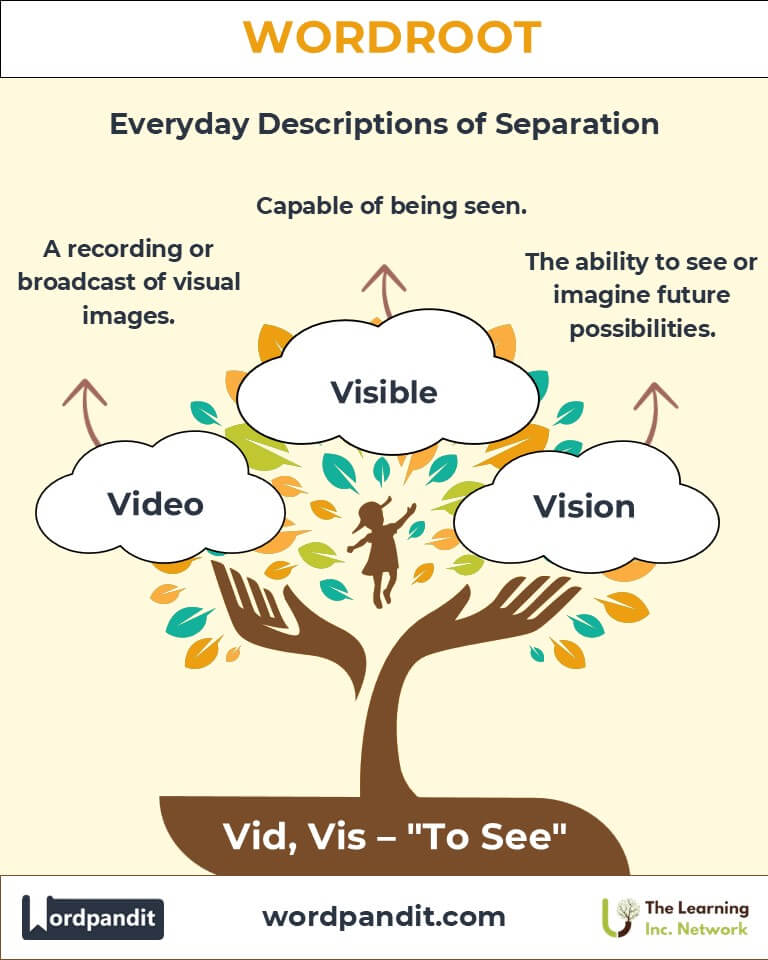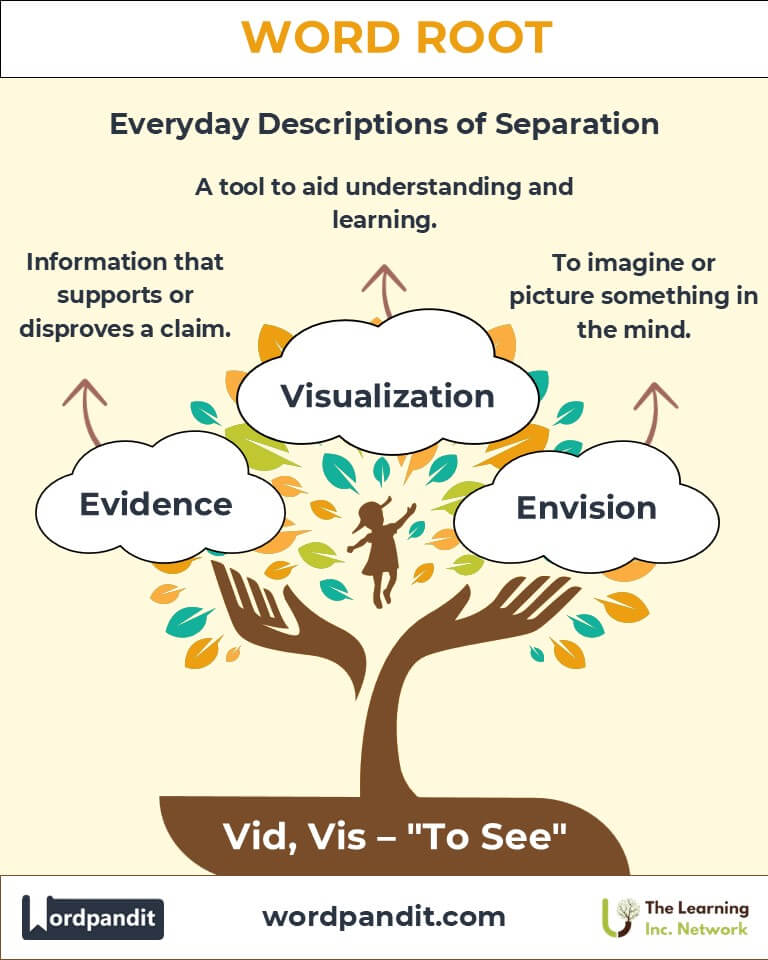Vid, Vis: The Roots of Vision and Insight
Byline: Discover the origins and significance of the Latin roots vid and vis, meaning "to see." From everyday words like "video" and "visible" to specialized terms such as "visualize" and "evidence," these roots have profoundly shaped language, offering a lens through which we understand perception and clarity.

Table of Contents
- Introduction: The Essence of "Vid" and "Vis"
- Etymology and Historical Journey
- Mnemonic: Unlocking the Power of "Vid" and "Vis"
- Common "Vid" and "Vis"-Related Terms
- "Vid" and "Vis" Through Time
- "Vid" and "Vis" in Specialized Fields
- Illustrative Story: "Vid" and "Vis" in Action
- Cultural Significance of "Vid" and "Vis"
- The "Vid" and "Vis" Family Tree
- FAQs About the "Vid" and "Vis" Word Root
- Test Your Knowledge: "Vid" and "Vis" Word Root Quiz
- Conclusion: The Living Legacy of "Vid" and "Vis"
Introduction: The Essence of "Vid" and "Vis"
The roots vid (pronounced "vid") and vis (pronounced "vis") derive from the Latin videre, meaning "to see." These roots are foundational to many words that explore the concepts of vision, perception, and understanding. In a world driven by visual and intellectual clarity, vid and vis remain central to language, connecting fields from technology (video) to law (evidence) and art (visualization).

Etymology and Historical Journey
The roots vid and vis stem from the Latin videre ("to see") and visus ("sight" or "vision"). First appearing in classical texts, they were used metaphorically as well as literally to describe clarity and insight. During the Middle Ages, as Latin influenced Old French and English, these roots morphed into terms like "visible" and "vision." The advent of optical technologies, such as cameras and microscopes, further expanded their significance.
Mnemonic: Unlocking the Power of "Vid" and "Vis"
To remember these roots, imagine a vivid movie screen (vid) bringing colorful scenes to life, or visualize a magnifying glass (vis) clarifying details.
Mnemonic Device: "Vid and Vis are the eyes of language—helping us see, understand, and envision."
Common "Vid" and "Vis"-Related Terms
- Video (VEE-dee-oh): A recording or broadcast of visual images.
Example: "The video of the concert went viral online." - Visible (VIZ-uh-buhl): Capable of being seen.
Example: "The lighthouse became visible as the fog cleared." - Vision (VIZH-un): The ability to see or imagine future possibilities.
Example: "Her vision for the project inspired the team." - Envision (en-VIZH-un): To imagine or picture something in the mind.
Example: "He could envision a bright future for the company." - Evidence (EV-ih-dens): Information that supports or disproves a claim.
Example: "The lawyer presented compelling evidence to the jury."
"Vid" and "Vis" Through Time
- Visage: (Medieval Era): Initially referring to a face, this term expanded to include expressions and appearances.
- Supervise: (Modern Era): Originating from the concept of overseeing, it gained prominence in the context of management and leadership.
- Video: (20th Century): With the invention of cameras and screens, vid evolved into a staple of entertainment and communication.
"Vid" and "Vis" in Specialized Fields
- Technology:
- Videography: The art and practice of capturing moving images.
Example: Used in filmmaking and digital content creation.
- Videography: The art and practice of capturing moving images.
- Law:
- Evidence: Central to proving cases in court.
Example: Forensic evidence plays a critical role in criminal investigations.
- Evidence: Central to proving cases in court.
- Medicine:
- Visual Acuity: A measure of clarity in sight.
Example: Tested during routine eye exams.
- Visual Acuity: A measure of clarity in sight.
- Education:
- Visualization: A tool to aid understanding and learning.
Example: Teachers use diagrams to help students visualize concepts.
- Visualization: A tool to aid understanding and learning.
Illustrative Story: "Vid" and "Vis" in Action
In a bustling newsroom, Maya, a video journalist, worked tirelessly on a documentary about climate change. As she edited hours of footage, her supervisor emphasized the importance of making the data visible and relatable to viewers. Maya's vision was to create a compelling narrative that would inspire action. Her efforts highlighted the power of vid and vis in shaping perceptions and driving change.
Cultural Significance of "Vid" and "Vis"
The roots vid and vis have deep cultural resonance. From ancient myths where gods granted visions of the future to modern cinema that brings stories to life, seeing has always been associated with understanding and enlightenment. Phrases like "seeing is believing" capture their profound role in human cognition and culture.

The "Vid" and "Vis" Family Tree
- Spec- (to look):
Examples: Spectacle, inspect. - Opt- (eye):
Examples: Optic, optical. - Scop- (to view):
Examples: Telescope, microscope.

FAQs About " Vid " and " Vis "
Q: What do the roots "vid" and "vis" mean?
A: The roots "vid" and "vis" come from the Latin words "videre" and "visus," meaning "to see." They form the basis of words related to vision, sight, or observation, such as "video," "visible," and "visionary."
Q: What is the difference between "visible" and "visionary"?
A: "Visible" refers to something that can be seen with the eyes, such as a visible object or feature. "Visionary," on the other hand, describes someone with foresight or imaginative insight into future possibilities, often beyond what is immediately visible.
Q: How is "video" related to the root "vid"?
A: "Video" comes from the Latin "videre," meaning "to see." It refers to moving images that are recorded, displayed, or transmitted, emphasizing the visual aspect of communication.
Q: What does "supervise" mean?
A: "Supervise" combines "super" (over) and "vis" (to see), meaning "to oversee." It involves observing or managing an activity or group to ensure tasks are completed correctly or rules are followed.
Q: Why is "evidence" connected to "vid"?
A: "Evidence" originates from the Latin "evidentia," meaning "obvious to sight or understanding." It highlights something that can be clearly seen or observed, often used to support arguments or conclusions.
Test Your Knowledge: " Vid " and " Vis " Mastery Quiz
1. What do the roots "vid" and "vis" mean?
2. Which word describes someone with foresight?
3. What does "supervise" mean?
4. What is the origin of the word "video"?
5. Why is "evidence" connected to sight?
Conclusion: The Living Legacy of "Vid" and "Vis"
The roots vid and vis illuminate our language, connecting the act of seeing with understanding and imagination. From ancient texts to modern innovations, their influence is vast and enduring. As technology advances, vid and vis will continue shaping how we perceive and engage with the world. See the possibilities, and envision your own contributions!












